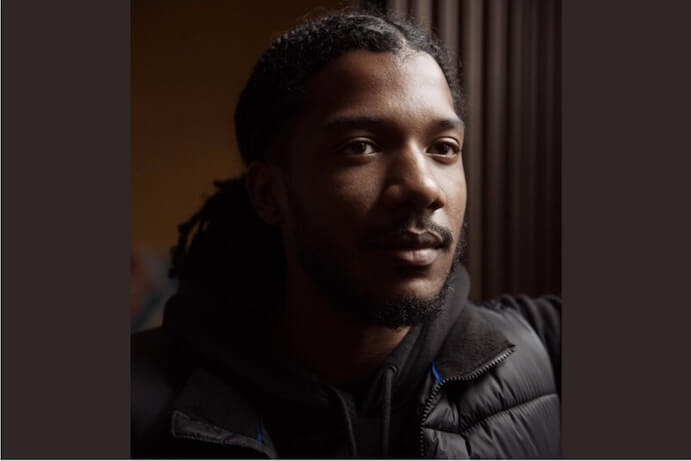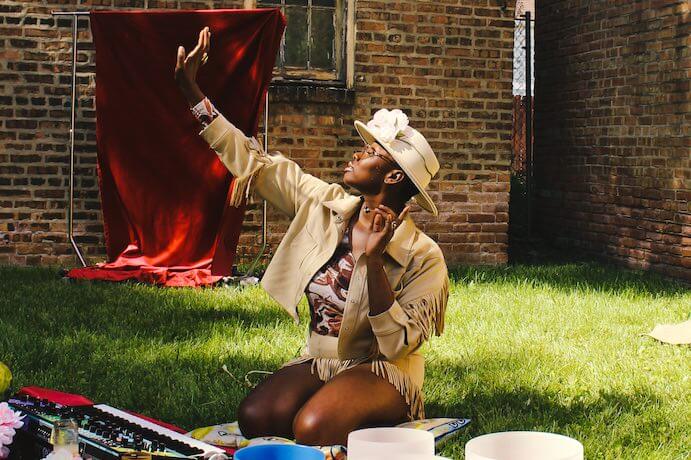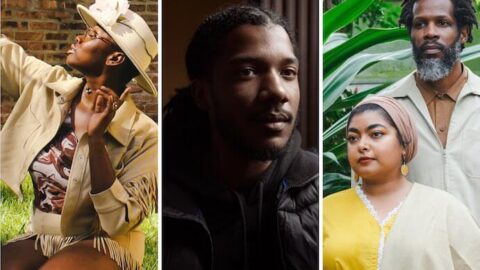Music and art have long been vehicles for resistance that are capable of evoking emotional and political change, whether that be through the beating of an Indigenous drum or boldly singing, “What’s going on?”
Resistance music contextualizes how it sounds to rebel against systems that disparage and slaughter marginalized groups that aren’t the personification of societal expectations. But resistance music doesn’t only call forth the problem – it can offer solutions and pathways toward healing.
Guitarist and vocalist Tazeen, one half of the Detroit-based duo Tazeen & Lufuki, sees resistance music as being a channel for our emotions and experiences in the present moment. It might not be solution-oriented, but it is a documentation of what we feel and see – and that is also an act of resistance.
“You are submitting to what you are being called to as opposed to doubt[ing it],” says Tazeen. “I feel like doubt trickles in, especially in the arts where many of us may think we’re not good enough, or maybe this doesn’t sound the way I think it should sound… but part of that is letting go of that doubt and trusting that there is something deeper that just needs to keep coming. Maybe it’s not just from me. Maybe it’s from my ancestors. Maybe it’s from something higher and I just have to get it out.”

Ahead of their “Sound & Resistance” performance on October 27, Tazeen along with Lufuki, Damon Williams, and Sophiyah E. have been reflecting on the cultural and political impact of opposition music, and how they’ve seen elders and ancestors use it to heal the masses and unlock newfound freedom.
Their performance is the final act of the four-part Seeds Series produced by Allied Media Projects (AMP), a Detroit-based non-profit organization that “cultivates media for liberation.” AMP Seeds explores and celebrates storytelling as a tool for change, movement organizing, joy, and care. The upcoming “Sound & Resistance” program, moderated by long-form storyteller Imani Mixon, evaluates the reciprocal relationship between music, movement, and resistance.
At the heart of this reciprocity is liberation, and that liberation carries us from generation to generation. History, unfortunately, repeats itself, so much so that we’ve had to revisit the same mountains our ancestors once climbed to reclaim our time and bodily autonomy. And these acts are rarely, if ever, performed by one individual. Whether it’s a social or political movement or a musical composition, moving forward with intention takes a collective effort, making resistance music inherently communal.
“Anything of any value – and resistance is of great value – is collective, is communally-informed and shaped,” says movement builder, organizer, hip-hop performing artist, educator, and media maker Damon Williams. “One of the things in all my work that I push greatly against, especially in this land, in the US, is individualism. I don’t believe in that notion. I don’t even actually use the word ‘individual’ anymore, because as you get into the root words of it – the etymology of it, what it kind of translates to – ‘individual’ is one divided from the whole, and I just don’t think that lines up with my understanding of humanity and the human experience and environment.”

This concept of communal effort has shaped some of the most revolutionary soundtracks and movements from the likes of Stevie Wonder, John Coltrane, Marvin Gaye, Josephine Baker, and Nina Simone. Composer and guitarist Lufuki says Stevie Wonder’s string of albums in the 70s were “basically prophetic.”
“You could play them right now and it still relates to the conditions of Black people today or the condition of the world. Or like global warming. He was talking about that in the early- to mid-’70s. All types of issues that still exist today.
“Another I would bring forward is Dr. Yusef Abdul Lateef, his song ‘Robot Man,’ which I think was an early-’80s song. Basically, he wrote songs about how man is reaching the level of becoming more robotic than human. It was almost like he’s giving a warning to future generations: don’t lose your humanity.”
The fact that these musicians are still relevant doesn’t take away from the artists of today. Kendrick Lamar, Beyonce, esperanza spalding, Lupe Fiasco, Erykah Badu, and Robert Glasper (to name a few) have in one way or another inspired resistance, whether by singing, “You won’t break my soul!” or chanting, “We gone be alright!”
Resisting suffering can bring forth greater possibilities of joy and health by shifting the unreconciled trauma that has conditioned communities to treat themselves and others in unhealthy ways, on top of living in an ever-violent environment. Suffering is to be expected on this journey, but the resistance that comes thereafter isn’t suffering.
You can have workshops and talk all day long about equity and justice…but you need a space where you can come together and just grieve together, heal together, find joy together.
“Resistance music is spiritual music,” says community advocate, producer, singer, and songwriter, Sophiyah E. “Spiritual music can’t be touched. It can’t be taught. It can’t be contained. It’s not content. It’s not entertainment. It is literally a message, almost like a message that is received based on your frequency, you know? It is a message that can’t be deciphered, because a lot of times, you know, our people, we know what we’re hearing. We’re coming in contact with our lineage.”
What’s truly dynamic about this spiritual work is that everyone interprets these sounds and melodies differently. The emotions triggered in one person won’t always be the same in another. They could inspire one group to march in the streets and another to shift political policies, or they could simply make someone finally feel seen, heard, and felt for the first time in their lives. Regardless of the impact, healing takes place.

“Sometimes you get so burnt out with taking action and resisting and pushing for policy change and pushing for social action…It can get really taxing and…it takes a lot and it can be really heavy…part of the purpose of this music, especially in our time that’s so important, is just the healing power of it,” Tazeen says. “You can have workshops and talk all day long about equity and justice, and you can have all of that, but you need a space where you can come together and just grieve together, heal together, find joy together.”
It takes a level of vulnerability to tap into this mode of expression, but it can be equally as healing for the artists as it is for their audience.
“I don’t have to make the song, the protest anthem, or the essay about my, you know, radical treatise,” Williams says. “I can actually just exist, talk about parts of my conscious observations that may not immediately come off as political, and that’s much more comfortable, much more human…healing has allowed me to show up to the work in a much more human way by, one, holding all of the ways I struggle, all of my limitations on a personal level, but also being able to live closer to my ideals of how people should relate to each other in the work, in the content, in the themes, and in the messages, whether they’re direct or coded.”
In the end, the revolution may not be televised, but it will be heard, felt, and seen through the movement, music, and resistance of the people.
I CARE IF YOU LISTEN is an editorially-independent program of the American Composers Forum, and is made possible thanks to generous donor and institutional support. Opinions expressed are solely those of the author and may not represent the views of ICIYL or ACF.
You can support the work of ICIYL with a tax-deductible gift to ACF. For more on ACF, visit the “At ACF” section or composersforum.org.
























